Home / Alkylation of Amines (Sucks!)
Amines
Alkylation of Amines (Sucks!)
Last updated: November 1st, 2022 |
Why Alkylation Of Amines (aka “The Williamson Ether Synthesis, But For Amines” ) Usually Doesn’t Pan Out
- Making a more-substituted amine from a less-substituted amine through treatment with an alkyl halide often fails, because the product amine is more nucleophilic than the starting amine.
- In some cases this is desired, as in the formation of alkylammonium salts with an excess of alkyl halide (e.g. CH3I)
- In other cases, the best approach to making a more substituted amine from a less substituted amine is generally reductive amination.

Table of Contents
- “The Williamson Ether Synthesis, But For Amines” : Why Does This Reaction Suck?
- The Runaway Train of Amine Alkylation, Step 1: SN2
- Step 2: Alkylation Is Followed By An Acid-Base Reaction…
- …Liberating An Amine That Is A Better Nucleophile: Step 3: A Second SN2
- Step 4: Another Acid-Base Reaction Makes An Even Better Nucleophile
- The Runaway Train Continues
- The Reaction Tends To Stop At Tertiary Amines. Usually.
- Summary: Alkylation Of Amines Generally Sucks. Here Are Some Workarounds
- Notes, plus “Exhaustive Methylation”
- (Advanced) References and Further Reading
1. Why Does This Reaction Suck?
Trends in the basicity of amines provide a classic example of why chemistry is so interesting; it’s deciphering the delicate trade-offs between various general factors in specific cases that gives chemists a buzz. The miraculous starts looking obvious.
– The Curious Wavefunction (Ash Jogalekar)
Today, let’s talk about how to make amines. It’s not as straightforward as you might think.
See if you can fill in the blank in the following skill-testing question:

Let’s walk through the thought process. We need to form a C-N bond. The N of NH3 has a lone pair and is a good nucleophile. So, much like the Williamson ether synthesis, maybe we can use an alkyl halide like ethyl bromide (CH3CH2Br) and boom! done.
It doesn’t quite turn out that way. In the words of the scientist who investigated this thoroughly:
“The interaction of ethyl bromide and ammonia… conduces largely to the formation of triethylamine”.
[ref: Werner, J. Chem. Soc. 1918, p. 899]
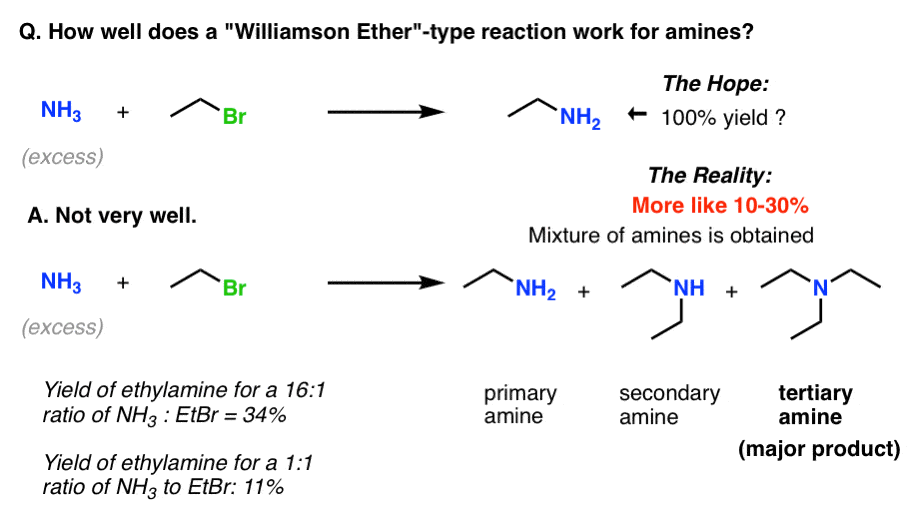
Formation of a primary amine through alkylation of ammonia turns out to be a pretty low-yielding reaction. (For reasons of economy, we generally want to use reactions that form one dominant product in high yield to avoid tedious separations: this doesn’t qualify.)
This is part of the fun* of learning organic chemistry. Just when you think you might have things figured out, along comes a curveball.
Why does this reaction. for lack of a better word, suck?
2. The Runaway Train of Amine Alkylation, Step 1: SN2
Let’s look at the first reaction that would happen the moment that a solution of ammonia is combined with ethyl bromide: nucleophilic substitution (via the SN2 mechanism)

3. Step 2: Alkylation Is Followed By An Acid Base Reaction
So far so good. We’ve formed our C-N bond. Since the reaction is in excess ammonia, an acid-base reaction can then lead to the neutralization of at least some of the ammonium salt, yielding us our neutral primary amine.
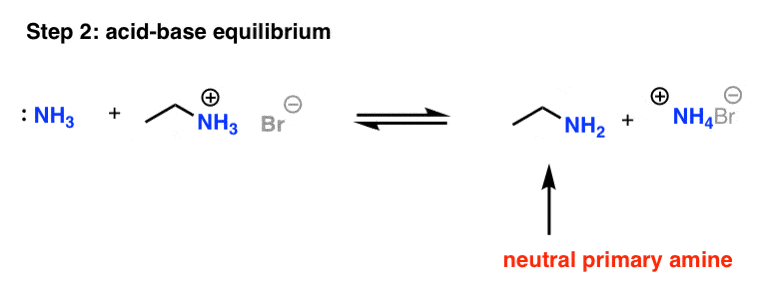
So now we have the primary amine. We’re done, right?
Not so fast. See, relative to substitution reactions, acid-base reactions are fast, so this deprotonation event will occur before the first substitution reaction has consumed all of the remaining ethyl bromide.
That means that ethylamine will be present in the same flask with ethyl bromide.
So?
4. Step 3: The Acid-Base Reaction Liberates An Amine Nucleophile That Is Even Better Than The Starting Amine
Well, ethylamine is itself a good nucleophile. In fact, it’s an even better nucleophile than ammonia itself, because of the electron-donating alkyl group [Link: 5 factors that affect the basicity of amines]
How much better? If we use pKaH as a proxy for nucleophilicity (reasonable, since steric hindrance isn’t a factor here) we have a pKaH of 10.7 for ethylamine versus 9.2 for NH3. That’s about 101.5 = 30 times more nucleophilic.
The ethylamine created by the first SN2 will start gobbling up the ethyl bromide… instead of NH3!
We’ve created a monster!
Even if we try to stack the deck with (say) a 15-fold excess of NH3, the reaction of ethylamine will still be faster by a factor of (30/15) = 2. [That’s what Werner did, above; the yield of EtNH2 was 34% under those conditions, versus 11% for just 1 equiv of NH3.]
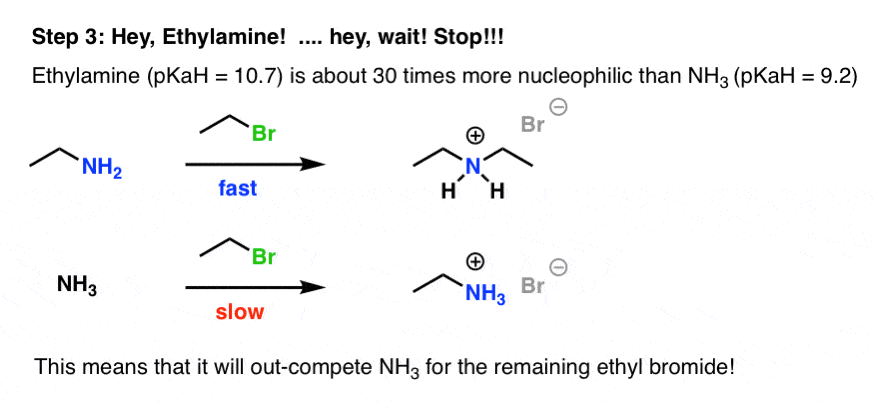
5. Step 4: Another Acid-Base Reaction Makes An Even Better Nucleophile
Now we have the diethylammonium product in the presence of excess base, which will lead to at least some formation of diethylamine.

You know what that means? Another nucleophile has been produced that will compete with NH3 for the remaining ethyl bromide.
How does the nucleophilicity compare to ammonia and ethylamine?
The pKaH of diethylamine is about 11.0, making it slightly more nucleophilic than ethylamine!
6. The Runaway Train Continues
Diethylamine, being a stronger nucleophile than both ammonia and ethylamine, will react faster with the remaining ethyl bromide than either of those two species. This will form triethylammonium bromide, which can then be deprotonated (using any one of the amine bases in solution) to form neutral triethylamine.
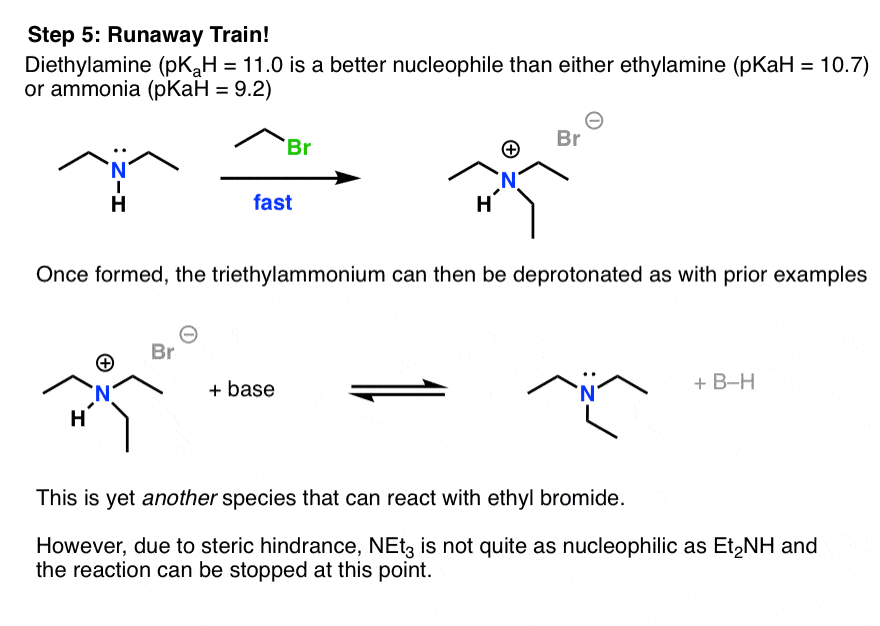
Now we have three nucleophilic amine species all swimming around in solution at the same time, before all of our ethyl bromide has been consumed.
This soup containing multiple amine products is the kind of reaction that my friend Jeff would describe in his lab notebook as a “BFM”. (The “B” is for “big”, and the “M” is for “mess”….)
7. The Reaction Tends To Stop At Tertiary Amines…
The “runaway train” usually stops at the tertiary amine stage. In this specific case, the pKaH of triethylamine is 10.75, a little less than diethylamine. [Recall that pKaH refers to basicity, not nucleophilicity: the basicity of NEt3 is attenuated here due to the lowered solubility of the conjugate acid in water. [more here]. ]
The nucleophilicity of triethylamine is less than that of diethyl amine largely because the triethylamine nitrogen is tertiary, which will increase steric hindrance and slow down the reaction rate.
For this reason, formation of tertiary amines from secondary amines via alkylation is thus, for the most part, exempt from our broad “amine alkylation is crap” statement.
8. Summary: Alkylation of Amines Generally Sucks. Here Are Some Workarounds
Otherwise, workarounds must be used. There are plenty. Azides are good nucleophiles for example, and they can be alkylated without incident and reduced to amines afterwards. The Gabriel Synthesis is another workaround.
What about our skill-testing question from the top of the article?
Here’s a reaction that most organic chemists would consider to be the best general way to make amines: a reaction called reductive amination.
Here’s a little sneak preview.
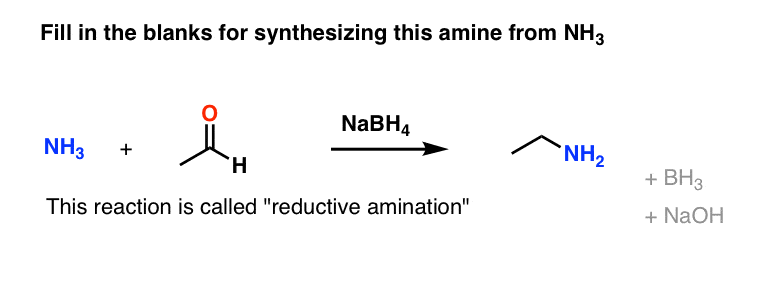
We’ll talk about how this reaction works in the next post , on reductive amination.
Notes
Related Articles
Note 1. Alkylation of ammonia mostly stopped at the tertiary amine stage.
Although tertiary amines tend to be less nucleophilic than secondary amines, they are still nucleophiles, and when treated with excess alkyl halide under forcing conditions they can be converted to quaternary ammonium salts.
The best example of this is with methyl iodide, in a reaction called exhaustive methylation. Recall that methyl halides are the fastest-reacting alkyl halides in SN2 reactions due to their low steric hindrance.
Treatment of amines with a large excess of methyl iodide leads to their quaternary ammonium salts. As we’ll see in a future post, these quaternary ammonium salts can behave as excellent leaving groups in elimination reactions (and, rarely, substitution reactions) to give alkenes, particularly in the Hofmann elimination.
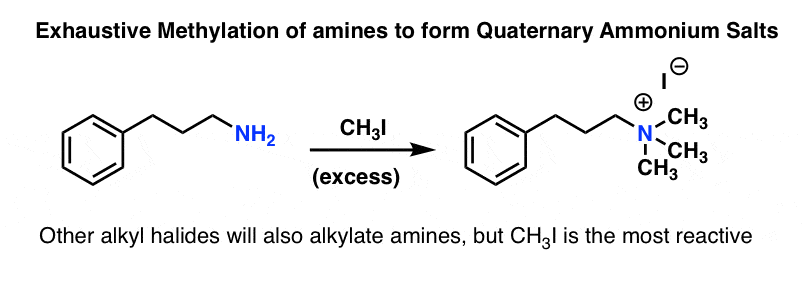
(Advanced) References and Further Reading
- —The preparation of ethylamine and of diethylamine
Emil Alphonse Werner
J. Chem. Soc. Trans. 1918, 113, 899-902
DOI: 10.1039/CT9181300899
An early report on the synthesis of alkylamines by alkylation of ammonia with ethyl bromide, and the second paragraph begins with “This is a faulty procedure, since it conduces largely to the formation of the less useful triethylamine, with consequent loss in the yields of the primary and secondary bases”. - Cesium Effect: High Chemoselectivity in Direct N-Alkylation of Amines
Ralph Nicholas Salvatore, Advait S. Nagle, and Kyung Woon Jung
The Journal of Organic Chemistry 2002, 67 (3), 674-683
DOI: 1021/jo010643c
The selective monoalkylation of amines is possible, provided you know how. - Efficient and selective N-alkylation of amines with alcohols catalysed by manganese pincer complexes
Saravanakumar Elangovan, Jacob Neumann, Jean-Baptiste Sortais, Kathrin Junge, Christophe Darcel & Matthias Beller
Nature Communications 2016, 7:12641
DOI: 10.1038/ncomms12641 - Selective Synthesis of Secondary and Tertiary Amines by Reductive N‐Alkylation of Nitriles and N‐Alkylation of Amines and Ammonium Formate Catalyzed by Ruthenium Complex
Iryna D. Alshakova, Dr. Georgii I. Nikonov
ChemCatChem 2019, 11 (21), 5370-5378
DOI: 10.1002/cctc.201900561
Both papers are on essentially the same reaction. The mechanism of these reactions shows that it is basically a ‘one-pot’ reductive amination. The alcohol is oxidized in situ and an excess of alcohol serves as a reductant. - Aqueous N-alkylation of amines using alkyl halides: direct generation of tertiary amines under microwave irradiation
Yuhong Jua and Rajender S. Varma
Green Chem., 2004, 6, 219-221
DOI: 10.1039/B401620C
This paper demonstrates that alkylation of secondary amines yields tertiary amines, obviously. But more importantly, quaternary ammonium salts are only formed with difficulty; this paper does not report any quaternary ammonium salt formation even after extended microwave heating of a secondary amine with excess alkyl halide.
00 General Chemistry Review
01 Bonding, Structure, and Resonance
- How Do We Know Methane (CH4) Is Tetrahedral?
- Hybrid Orbitals and Hybridization
- How To Determine Hybridization: A Shortcut
- Orbital Hybridization And Bond Strengths
- Sigma bonds come in six varieties: Pi bonds come in one
- A Key Skill: How to Calculate Formal Charge
- The Four Intermolecular Forces and How They Affect Boiling Points
- 3 Trends That Affect Boiling Points
- How To Use Electronegativity To Determine Electron Density (and why NOT to trust formal charge)
- Introduction to Resonance
- How To Use Curved Arrows To Interchange Resonance Forms
- Evaluating Resonance Forms (1) - The Rule of Least Charges
- How To Find The Best Resonance Structure By Applying Electronegativity
- Evaluating Resonance Structures With Negative Charges
- Evaluating Resonance Structures With Positive Charge
- Exploring Resonance: Pi-Donation
- Exploring Resonance: Pi-acceptors
- In Summary: Evaluating Resonance Structures
- Drawing Resonance Structures: 3 Common Mistakes To Avoid
- How to apply electronegativity and resonance to understand reactivity
- Bond Hybridization Practice
- Structure and Bonding Practice Quizzes
- Resonance Structures Practice
02 Acid Base Reactions
- Introduction to Acid-Base Reactions
- Acid Base Reactions In Organic Chemistry
- The Stronger The Acid, The Weaker The Conjugate Base
- Walkthrough of Acid-Base Reactions (3) - Acidity Trends
- Five Key Factors That Influence Acidity
- Acid-Base Reactions: Introducing Ka and pKa
- How to Use a pKa Table
- The pKa Table Is Your Friend
- A Handy Rule of Thumb for Acid-Base Reactions
- Acid Base Reactions Are Fast
- pKa Values Span 60 Orders Of Magnitude
- How Protonation and Deprotonation Affect Reactivity
- Acid Base Practice Problems
03 Alkanes and Nomenclature
- Meet the (Most Important) Functional Groups
- Condensed Formulas: Deciphering What the Brackets Mean
- Hidden Hydrogens, Hidden Lone Pairs, Hidden Counterions
- Don't Be Futyl, Learn The Butyls
- Primary, Secondary, Tertiary, Quaternary In Organic Chemistry
- Branching, and Its Affect On Melting and Boiling Points
- The Many, Many Ways of Drawing Butane
- Wedge And Dash Convention For Tetrahedral Carbon
- Common Mistakes in Organic Chemistry: Pentavalent Carbon
- Table of Functional Group Priorities for Nomenclature
- Summary Sheet - Alkane Nomenclature
- Organic Chemistry IUPAC Nomenclature Demystified With A Simple Puzzle Piece Approach
- Boiling Point Quizzes
- Organic Chemistry Nomenclature Quizzes
04 Conformations and Cycloalkanes
- Staggered vs Eclipsed Conformations of Ethane
- Conformational Isomers of Propane
- Newman Projection of Butane (and Gauche Conformation)
- Introduction to Cycloalkanes
- Geometric Isomers In Small Rings: Cis And Trans Cycloalkanes
- Calculation of Ring Strain In Cycloalkanes
- Cycloalkanes - Ring Strain In Cyclopropane And Cyclobutane
- Cyclohexane Conformations
- Cyclohexane Chair Conformation: An Aerial Tour
- How To Draw The Cyclohexane Chair Conformation
- The Cyclohexane Chair Flip
- The Cyclohexane Chair Flip - Energy Diagram
- Substituted Cyclohexanes - Axial vs Equatorial
- Ranking The Bulkiness Of Substituents On Cyclohexanes: "A-Values"
- Cyclohexane Chair Conformation Stability: Which One Is Lower Energy?
- Fused Rings - Cis-Decalin and Trans-Decalin
- Naming Bicyclic Compounds - Fused, Bridged, and Spiro
- Bredt's Rule (And Summary of Cycloalkanes)
- Newman Projection Practice
- Cycloalkanes Practice Problems
05 A Primer On Organic Reactions
- The Most Important Question To Ask When Learning a New Reaction
- Learning New Reactions: How Do The Electrons Move?
- The Third Most Important Question to Ask When Learning A New Reaction
- 7 Factors that stabilize negative charge in organic chemistry
- 7 Factors That Stabilize Positive Charge in Organic Chemistry
- Nucleophiles and Electrophiles
- Curved Arrows (for reactions)
- Curved Arrows (2): Initial Tails and Final Heads
- Nucleophilicity vs. Basicity
- The Three Classes of Nucleophiles
- What Makes A Good Nucleophile?
- What makes a good leaving group?
- 3 Factors That Stabilize Carbocations
- Equilibrium and Energy Relationships
- What's a Transition State?
- Hammond's Postulate
- Learning Organic Chemistry Reactions: A Checklist (PDF)
- Introduction to Free Radical Substitution Reactions
- Introduction to Oxidative Cleavage Reactions
06 Free Radical Reactions
- Bond Dissociation Energies = Homolytic Cleavage
- Free Radical Reactions
- 3 Factors That Stabilize Free Radicals
- What Factors Destabilize Free Radicals?
- Bond Strengths And Radical Stability
- Free Radical Initiation: Why Is "Light" Or "Heat" Required?
- Initiation, Propagation, Termination
- Monochlorination Products Of Propane, Pentane, And Other Alkanes
- Selectivity In Free Radical Reactions
- Selectivity in Free Radical Reactions: Bromination vs. Chlorination
- Halogenation At Tiffany's
- Allylic Bromination
- Bonus Topic: Allylic Rearrangements
- In Summary: Free Radicals
- Synthesis (2) - Reactions of Alkanes
- Free Radicals Practice Quizzes
07 Stereochemistry and Chirality
- Types of Isomers: Constitutional Isomers, Stereoisomers, Enantiomers, and Diastereomers
- How To Draw The Enantiomer Of A Chiral Molecule
- How To Draw A Bond Rotation
- Introduction to Assigning (R) and (S): The Cahn-Ingold-Prelog Rules
- Assigning Cahn-Ingold-Prelog (CIP) Priorities (2) - The Method of Dots
- Enantiomers vs Diastereomers vs The Same? Two Methods For Solving Problems
- Assigning R/S To Newman Projections (And Converting Newman To Line Diagrams)
- How To Determine R and S Configurations On A Fischer Projection
- The Meso Trap
- Optical Rotation, Optical Activity, and Specific Rotation
- Optical Purity and Enantiomeric Excess
- What's a Racemic Mixture?
- Chiral Allenes And Chiral Axes
- Stereochemistry Practice Problems and Quizzes
08 Substitution Reactions
- Nucleophilic Substitution Reactions - Introduction
- Two Types of Nucleophilic Substitution Reactions
- The SN2 Mechanism
- Why the SN2 Reaction Is Powerful
- The SN1 Mechanism
- The Conjugate Acid Is A Better Leaving Group
- Comparing the SN1 and SN2 Reactions
- Polar Protic? Polar Aprotic? Nonpolar? All About Solvents
- Steric Hindrance is Like a Fat Goalie
- Common Blind Spot: Intramolecular Reactions
- Substitution Practice - SN1
- Substitution Practice - SN2
09 Elimination Reactions
- Elimination Reactions (1): Introduction And The Key Pattern
- Elimination Reactions (2): The Zaitsev Rule
- Elimination Reactions Are Favored By Heat
- Two Elimination Reaction Patterns
- The E1 Reaction
- The E2 Mechanism
- E1 vs E2: Comparing the E1 and E2 Reactions
- Antiperiplanar Relationships: The E2 Reaction and Cyclohexane Rings
- Bulky Bases in Elimination Reactions
- Comparing the E1 vs SN1 Reactions
- Elimination (E1) Reactions With Rearrangements
- E1cB - Elimination (Unimolecular) Conjugate Base
- Elimination (E1) Practice Problems And Solutions
- Elimination (E2) Practice Problems and Solutions
10 Rearrangements
11 SN1/SN2/E1/E2 Decision
- Identifying Where Substitution and Elimination Reactions Happen
- Deciding SN1/SN2/E1/E2 (1) - The Substrate
- Deciding SN1/SN2/E1/E2 (2) - The Nucleophile/Base
- SN1 vs E1 and SN2 vs E2 : The Temperature
- Deciding SN1/SN2/E1/E2 - The Solvent
- Wrapup: The Key Factors For Determining SN1/SN2/E1/E2
- Alkyl Halide Reaction Map And Summary
- SN1 SN2 E1 E2 Practice Problems
12 Alkene Reactions
- E and Z Notation For Alkenes (+ Cis/Trans)
- Alkene Stability
- Alkene Addition Reactions: "Regioselectivity" and "Stereoselectivity" (Syn/Anti)
- Stereoselective and Stereospecific Reactions
- Hydrohalogenation of Alkenes and Markovnikov's Rule
- Hydration of Alkenes With Aqueous Acid
- Rearrangements in Alkene Addition Reactions
- Halogenation of Alkenes and Halohydrin Formation
- Oxymercuration Demercuration of Alkenes
- Hydroboration Oxidation of Alkenes
- m-CPBA (meta-chloroperoxybenzoic acid)
- OsO4 (Osmium Tetroxide) for Dihydroxylation of Alkenes
- Palladium on Carbon (Pd/C) for Catalytic Hydrogenation of Alkenes
- Cyclopropanation of Alkenes
- A Fourth Alkene Addition Pattern - Free Radical Addition
- Alkene Reactions: Ozonolysis
- Summary: Three Key Families Of Alkene Reaction Mechanisms
- Synthesis (4) - Alkene Reaction Map, Including Alkyl Halide Reactions
- Alkene Reactions Practice Problems
13 Alkyne Reactions
- Acetylides from Alkynes, And Substitution Reactions of Acetylides
- Partial Reduction of Alkynes With Lindlar's Catalyst
- Partial Reduction of Alkynes With Na/NH3 To Obtain Trans Alkenes
- Alkyne Hydroboration With "R2BH"
- Hydration and Oxymercuration of Alkynes
- Hydrohalogenation of Alkynes
- Alkyne Halogenation: Bromination, Chlorination, and Iodination of Alkynes
- Alkyne Reactions - The "Concerted" Pathway
- Alkenes To Alkynes Via Halogenation And Elimination Reactions
- Alkynes Are A Blank Canvas
- Synthesis (5) - Reactions of Alkynes
- Alkyne Reactions Practice Problems With Answers
14 Alcohols, Epoxides and Ethers
- Alcohols - Nomenclature and Properties
- Alcohols Can Act As Acids Or Bases (And Why It Matters)
- Alcohols - Acidity and Basicity
- The Williamson Ether Synthesis
- Ethers From Alkenes, Tertiary Alkyl Halides and Alkoxymercuration
- Alcohols To Ethers via Acid Catalysis
- Cleavage Of Ethers With Acid
- Epoxides - The Outlier Of The Ether Family
- Opening of Epoxides With Acid
- Epoxide Ring Opening With Base
- Making Alkyl Halides From Alcohols
- Tosylates And Mesylates
- PBr3 and SOCl2
- Elimination Reactions of Alcohols
- Elimination of Alcohols To Alkenes With POCl3
- Alcohol Oxidation: "Strong" and "Weak" Oxidants
- Demystifying The Mechanisms of Alcohol Oxidations
- Protecting Groups For Alcohols
- Thiols And Thioethers
- Calculating the oxidation state of a carbon
- Oxidation and Reduction in Organic Chemistry
- Oxidation Ladders
- SOCl2 Mechanism For Alcohols To Alkyl Halides: SN2 versus SNi
- Alcohol Reactions Roadmap (PDF)
- Alcohol Reaction Practice Problems
- Epoxide Reaction Quizzes
- Oxidation and Reduction Practice Quizzes
15 Organometallics
- What's An Organometallic?
- Formation of Grignard and Organolithium Reagents
- Organometallics Are Strong Bases
- Reactions of Grignard Reagents
- Protecting Groups In Grignard Reactions
- Synthesis Problems Involving Grignard Reagents
- Grignard Reactions And Synthesis (2)
- Organocuprates (Gilman Reagents): How They're Made
- Gilman Reagents (Organocuprates): What They're Used For
- The Heck, Suzuki, and Olefin Metathesis Reactions (And Why They Don't Belong In Most Introductory Organic Chemistry Courses)
- Reaction Map: Reactions of Organometallics
- Grignard Practice Problems
16 Spectroscopy
- Degrees of Unsaturation (or IHD, Index of Hydrogen Deficiency)
- Conjugation And Color (+ How Bleach Works)
- Introduction To UV-Vis Spectroscopy
- UV-Vis Spectroscopy: Absorbance of Carbonyls
- UV-Vis Spectroscopy: Practice Questions
- Bond Vibrations, Infrared Spectroscopy, and the "Ball and Spring" Model
- Infrared Spectroscopy: A Quick Primer On Interpreting Spectra
- IR Spectroscopy: 4 Practice Problems
- 1H NMR: How Many Signals?
- Homotopic, Enantiotopic, Diastereotopic
- Diastereotopic Protons in 1H NMR Spectroscopy: Examples
- C13 NMR - How Many Signals
- Liquid Gold: Pheromones In Doe Urine
- Natural Product Isolation (1) - Extraction
- Natural Product Isolation (2) - Purification Techniques, An Overview
- Structure Determination Case Study: Deer Tarsal Gland Pheromone
17 Dienes and MO Theory
- What To Expect In Organic Chemistry 2
- Are these molecules conjugated?
- Conjugation And Resonance In Organic Chemistry
- Bonding And Antibonding Pi Orbitals
- Molecular Orbitals of The Allyl Cation, Allyl Radical, and Allyl Anion
- Pi Molecular Orbitals of Butadiene
- Reactions of Dienes: 1,2 and 1,4 Addition
- Thermodynamic and Kinetic Products
- More On 1,2 and 1,4 Additions To Dienes
- s-cis and s-trans
- The Diels-Alder Reaction
- Cyclic Dienes and Dienophiles in the Diels-Alder Reaction
- Stereochemistry of the Diels-Alder Reaction
- Exo vs Endo Products In The Diels Alder: How To Tell Them Apart
- HOMO and LUMO In the Diels Alder Reaction
- Why Are Endo vs Exo Products Favored in the Diels-Alder Reaction?
- Diels-Alder Reaction: Kinetic and Thermodynamic Control
- The Retro Diels-Alder Reaction
- The Intramolecular Diels Alder Reaction
- Regiochemistry In The Diels-Alder Reaction
- The Cope and Claisen Rearrangements
- Electrocyclic Reactions
- Electrocyclic Ring Opening And Closure (2) - Six (or Eight) Pi Electrons
- Diels Alder Practice Problems
- Molecular Orbital Theory Practice
18 Aromaticity
- Introduction To Aromaticity
- Rules For Aromaticity
- Huckel's Rule: What Does 4n+2 Mean?
- Aromatic, Non-Aromatic, or Antiaromatic? Some Practice Problems
- Antiaromatic Compounds and Antiaromaticity
- The Pi Molecular Orbitals of Benzene
- The Pi Molecular Orbitals of Cyclobutadiene
- Frost Circles
- Aromaticity Practice Quizzes
19 Reactions of Aromatic Molecules
- Electrophilic Aromatic Substitution: Introduction
- Activating and Deactivating Groups In Electrophilic Aromatic Substitution
- Electrophilic Aromatic Substitution - The Mechanism
- Ortho-, Para- and Meta- Directors in Electrophilic Aromatic Substitution
- Understanding Ortho, Para, and Meta Directors
- Why are halogens ortho- para- directors?
- Disubstituted Benzenes: The Strongest Electron-Donor "Wins"
- Electrophilic Aromatic Substitutions (1) - Halogenation of Benzene
- Electrophilic Aromatic Substitutions (2) - Nitration and Sulfonation
- EAS Reactions (3) - Friedel-Crafts Acylation and Friedel-Crafts Alkylation
- Intramolecular Friedel-Crafts Reactions
- Nucleophilic Aromatic Substitution (NAS)
- Nucleophilic Aromatic Substitution (2) - The Benzyne Mechanism
- Reactions on the "Benzylic" Carbon: Bromination And Oxidation
- The Wolff-Kishner, Clemmensen, And Other Carbonyl Reductions
- More Reactions on the Aromatic Sidechain: Reduction of Nitro Groups and the Baeyer Villiger
- Aromatic Synthesis (1) - "Order Of Operations"
- Synthesis of Benzene Derivatives (2) - Polarity Reversal
- Aromatic Synthesis (3) - Sulfonyl Blocking Groups
- Birch Reduction
- Synthesis (7): Reaction Map of Benzene and Related Aromatic Compounds
- Aromatic Reactions and Synthesis Practice
- Electrophilic Aromatic Substitution Practice Problems
20 Aldehydes and Ketones
- What's The Alpha Carbon In Carbonyl Compounds?
- Nucleophilic Addition To Carbonyls
- Aldehydes and Ketones: 14 Reactions With The Same Mechanism
- Sodium Borohydride (NaBH4) Reduction of Aldehydes and Ketones
- Grignard Reagents For Addition To Aldehydes and Ketones
- Wittig Reaction
- Hydrates, Hemiacetals, and Acetals
- Imines - Properties, Formation, Reactions, and Mechanisms
- All About Enamines
- Breaking Down Carbonyl Reaction Mechanisms: Reactions of Anionic Nucleophiles (Part 2)
- Aldehydes Ketones Reaction Practice
21 Carboxylic Acid Derivatives
- Nucleophilic Acyl Substitution (With Negatively Charged Nucleophiles)
- Addition-Elimination Mechanisms With Neutral Nucleophiles (Including Acid Catalysis)
- Basic Hydrolysis of Esters - Saponification
- Transesterification
- Proton Transfer
- Fischer Esterification - Carboxylic Acid to Ester Under Acidic Conditions
- Lithium Aluminum Hydride (LiAlH4) For Reduction of Carboxylic Acid Derivatives
- LiAlH[Ot-Bu]3 For The Reduction of Acid Halides To Aldehydes
- Di-isobutyl Aluminum Hydride (DIBAL) For The Partial Reduction of Esters and Nitriles
- Amide Hydrolysis
- Thionyl Chloride (SOCl2)
- Diazomethane (CH2N2)
- Carbonyl Chemistry: Learn Six Mechanisms For the Price Of One
- Making Music With Mechanisms (PADPED)
- Carboxylic Acid Derivatives Practice Questions
22 Enols and Enolates
- Keto-Enol Tautomerism
- Enolates - Formation, Stability, and Simple Reactions
- Kinetic Versus Thermodynamic Enolates
- Aldol Addition and Condensation Reactions
- Reactions of Enols - Acid-Catalyzed Aldol, Halogenation, and Mannich Reactions
- Claisen Condensation and Dieckmann Condensation
- Decarboxylation
- The Malonic Ester and Acetoacetic Ester Synthesis
- The Michael Addition Reaction and Conjugate Addition
- The Robinson Annulation
- Haloform Reaction
- The Hell–Volhard–Zelinsky Reaction
- Enols and Enolates Practice Quizzes
23 Amines
- The Amide Functional Group: Properties, Synthesis, and Nomenclature
- Basicity of Amines And pKaH
- 5 Key Basicity Trends of Amines
- The Mesomeric Effect And Aromatic Amines
- Nucleophilicity of Amines
- Alkylation of Amines (Sucks!)
- Reductive Amination
- The Gabriel Synthesis
- Some Reactions of Azides
- The Hofmann Elimination
- The Hofmann and Curtius Rearrangements
- The Cope Elimination
- Protecting Groups for Amines - Carbamates
- The Strecker Synthesis of Amino Acids
- Introduction to Peptide Synthesis
- Reactions of Diazonium Salts: Sandmeyer and Related Reactions
- Amine Practice Questions
24 Carbohydrates
- D and L Notation For Sugars
- Pyranoses and Furanoses: Ring-Chain Tautomerism In Sugars
- What is Mutarotation?
- Reducing Sugars
- The Big Damn Post Of Carbohydrate-Related Chemistry Definitions
- The Haworth Projection
- Converting a Fischer Projection To A Haworth (And Vice Versa)
- Reactions of Sugars: Glycosylation and Protection
- The Ruff Degradation and Kiliani-Fischer Synthesis
- Isoelectric Points of Amino Acids (and How To Calculate Them)
- Carbohydrates Practice
- Amino Acid Quizzes
25 Fun and Miscellaneous
- A Gallery of Some Interesting Molecules From Nature
- Screw Organic Chemistry, I'm Just Going To Write About Cats
- On Cats, Part 1: Conformations and Configurations
- On Cats, Part 2: Cat Line Diagrams
- On Cats, Part 4: Enantiocats
- On Cats, Part 6: Stereocenters
- Organic Chemistry Is Shit
- The Organic Chemistry Behind "The Pill"
- Maybe they should call them, "Formal Wins" ?
- Why Do Organic Chemists Use Kilocalories?
- The Principle of Least Effort
- Organic Chemistry GIFS - Resonance Forms
- Reproducibility In Organic Chemistry
- What Holds The Nucleus Together?
- How Reactions Are Like Music
- Organic Chemistry and the New MCAT
26 Organic Chemistry Tips and Tricks
- Common Mistakes: Formal Charges Can Mislead
- Partial Charges Give Clues About Electron Flow
- Draw The Ugly Version First
- Organic Chemistry Study Tips: Learn the Trends
- The 8 Types of Arrows In Organic Chemistry, Explained
- Top 10 Skills To Master Before An Organic Chemistry 2 Final
- Common Mistakes with Carbonyls: Carboxylic Acids... Are Acids!
- Planning Organic Synthesis With "Reaction Maps"
- Alkene Addition Pattern #1: The "Carbocation Pathway"
- Alkene Addition Pattern #2: The "Three-Membered Ring" Pathway
- Alkene Addition Pattern #3: The "Concerted" Pathway
- Number Your Carbons!
- The 4 Major Classes of Reactions in Org 1
- How (and why) electrons flow
- Grossman's Rule
- Three Exam Tips
- A 3-Step Method For Thinking Through Synthesis Problems
- Putting It Together
- Putting Diels-Alder Products in Perspective
- The Ups and Downs of Cyclohexanes
- The Most Annoying Exceptions in Org 1 (Part 1)
- The Most Annoying Exceptions in Org 1 (Part 2)
- The Marriage May Be Bad, But the Divorce Still Costs Money
- 9 Nomenclature Conventions To Know
- Nucleophile attacks Electrophile
27 Case Studies of Successful O-Chem Students
- Success Stories: How Corina Got The The "Hard" Professor - And Got An A+ Anyway
- How Helena Aced Organic Chemistry
- From a "Drop" To B+ in Org 2 – How A Hard Working Student Turned It Around
- How Serge Aced Organic Chemistry
- Success Stories: How Zach Aced Organic Chemistry 1
- Success Stories: How Kari Went From C– to B+
- How Esther Bounced Back From a "C" To Get A's In Organic Chemistry 1 And 2
- How Tyrell Got The Highest Grade In Her Organic Chemistry Course
- This Is Why Students Use Flashcards
- Success Stories: How Stu Aced Organic Chemistry
- How John Pulled Up His Organic Chemistry Exam Grades
- Success Stories: How Nathan Aced Organic Chemistry (Without It Taking Over His Life)
- How Chris Aced Org 1 and Org 2
- Interview: How Jay Got an A+ In Organic Chemistry
- How to Do Well in Organic Chemistry: One Student's Advice
- "America's Top TA" Shares His Secrets For Teaching O-Chem
- "Organic Chemistry Is Like..." - A Few Metaphors
- How To Do Well In Organic Chemistry: Advice From A Tutor
- Guest post: "I went from being afraid of tests to actually looking forward to them".
Dear Dr Ashenhurst,
I was wondering whether the link you added about why tertiary amines are less basic than secondary amines paints a full picture regarding the formation of a quaternary ammonium salt. Whereas one could rightly make the argument that triethylamine is slightly less basic than diethylamine in an aqueous medium, the SN2 reaction could be performed using a polar solvent that isn’t water, right? So couldn’t the comparitively more polar nature of the pentacoordinate transition state and ionic nature of the subsequent salt be stabilised in a sufficiently polar solvent that isn’t water? I ask this because I was taught in my second year of undergrad that the rate of reaction of n-Pr3N + MeI (SN2) could be increased by increasing the polarity of the solvent used due to the reason the increased polarity of the TS compared to the reactants.
Kind regards,
Vignesh
This [site](https://www.chemguide.co.uk/organicprops/haloalkanes/nh3.html) says primary amine to be the major product in excess of ammonia. Is it wrong?
Werner, J. Chem. Soc. 1918, p. 899 tried a 16:1 ratio of NH3 to ethylamine and got 34% yield of the amine. Maybe if you used a 50:1 or 100:1 ratio of NH3 to alkyl halide, then it would have a higher yield. But that’s starting to get to be a fairly impractical process.
Thank you very much, this is the only article through which I understood the above reaction.
Dr.James greetings from my side.I have read lot of articles by you on different topics of organic chemistry and i really appreciate the way you make the students understand organic chemistry like a breeze.
I also refer your blogs to my students when they are stuck with some really difficult topics like complex mechanisms of the reactions and other topics.
Thanks